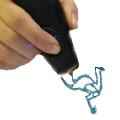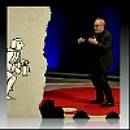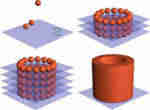Latest Science Inventions
Sterilizing Spray

This latest science invention is a spray-on invisible thin glass coating that sterilizes, protects and strengthens surfaces.
The coating also repels water, dirt, stains, mildew, fungus, bacteria and viruses.
A liquid coating invented at the Saarbrücken Institute for New Materials in Turkey and patented by Nanopool GmbH Germany, is a flexible and breathable spray-on glass film.
The film is approximately 100 nanometres thick (500 times thinner than a human hair) and has multiple applications and uses in numerous fields.
The coating is environmentally friendly (Winner of the Green Apple Award).
It can be applied within seconds to make any surface very easy to clean and safe from anti-microbes (Winner of the NHS Smart Solutions Award).
The special glass coating known as "SiO2 ultra-thin layering" protects practically any surface against water, uv radiation, dirt, heat, acid, stains, mildew, fungus. bacteria and viruses.
Trials by food processing plants in Germany have concluded that surfaces coated with liquid glass only need hot water for cleaning. In fact, the coating provided higher levels of sterility than surfaces cleaned with bleach or other chemicals.
A year long trial at a British hospital in Southport, Lancashire is to be published soon with very promising results for a wide range of coating applications used on medical equipment, implants, catheters, sutures and bandages.
Trials for in-vivo applications are confidential, but Neil McClelland, the UK Project Manager for Nanopool GmbH, describes the results as "stunning".
"Items such as stents can be coated, and this will create anti sticking features. Catheters and sutures which are a source of infection, will also cease to be problematic," he says.
Colin Humphreys, a professor of materials science at Cambridge University, commented that liquid glass appears to have a wide range of applications and that the product 'looks impressive'.
The investment opportunities for this latest science invention seem endless - buildings, vehicles, appliances, clothing etc. can have dirt and germ free surfaces without using toxic coatings or chemicals.
Sources: nanopool.eu;dailymail.co.uk Graphics: Cinezi
Three Dimensional Printing

Inventors Max Bogue and Peter Dilworth have invented a unique pen that draws in the air.
A colorful spool of plastic thread is fed into the pen.
The thread is then extruded as heated plastic that cools and solidifies instantly as it exits the tip.
This allows solid 3D structures to be drawn on any surface or from any surface into the air.
The pen, called a 3Doodler, weights approximately 7 ounces (198 g) and is 7 inches (17.7 cm) long. It requires no technical knowledge or software and plugs into an electrical outlet.
Max and Peter have received over 2.2 million dollars worth of advanced orders for their three dimensional printing pen.
They expect to fulfill those orders and launch the product in the fall of this year.
The co-inventors met while working for WowWee, a company based in Hong Kong that develops consumer technologies.
Peter consulted WowWee as an independent inventor. He had previously worked on robotics at MIT and contributed to a number of innovations including the infamous Uno Dicycle motorcycle.
Max was an R&D project manager with WowWee and has extensive experience in bringing products to market.
Source: the3doodler.com
Science Discoveries

Adam Savage, creative innovator and famed host of "MythBusters" on the Discovery Channel, gives examples of how simple ideas can lead to scientific discoveries.
He dramatically illustrates how the speed of light was discovered in 1849 and how the circumference of earth was discovered in 200 BC.
A very entertaining presentation that suggests we're all scientists when it comes to informed creative thinking.
Sources: ted.com; popularmechanics.com
Building Human Organs

Oganovo is a company based in San Diego, California.
Their latest science invention is a technology (novogen) which allows living tissue cells to be assembled into patterns and complex structures, such as organs.
Organovo has partnered with Invetech. a company based in Australia, to develop a bio-printer.
The device prints (places) human cells in a three-dimensional matrix to construct human tissue.
"Building human organs cell-by-cell was considered science fiction not that long ago," says Fred Davis of Invetech.
Currently, the bio-printer can grow blood vessels. It is anticipated that within five years the device will construct arteries and by 2020 sophisticated organs will be built by the device.
Source: organovo.com; Photo: Organovo
Glass Nanobots Absorb Toxins
 A nanobot particle made from glass is being developed that can absorb pollutants from contaminated water.
A nanobot particle made from glass is being developed that can absorb pollutants from contaminated water.
The glass particles act like sponges by attracting and binding contaminants to themselves and expanding eight times in size during the process.
But unlike a sponge, these nanobots are hydrophobic, meaning they don't absorb water.
Scientists claim this new technology could be used to clean petroleum spills or other hazardous chemicals from our waterways. After the particles are dropped into the water, they collect pollutants and then rise to the surface when fully expanded. The particles are then skimmed from the surface, cleaned and placed back into the water to repeat the process.
Source: absmaterials.com
Water Drop Lens

Physicist and inventor, Bruno Berge, has created a liquid optical lens.
Using a process known as electro-wetting, a water drop is deposited on a metal substrate and covered by a thin insulating layer. When a voltage is applied to the metal, it modifies the angle of the liquid drop.
The liquid lens is comprised of two liquids, water and oil, one is a conductor while the other is an insulator. A variation in the voltage causes a change to the curvature of the liquid to liquid interface, which changes the focal length of the lens.
The use of liquids allows for low cost construction. There are no moving parts and electrical consumption is extremely low. The lens has a large inverse focal length range, quick response, high optical quality and can operate in a wide temperature range.
See Also: Future Contact Lenses
Source: varioptic.com





